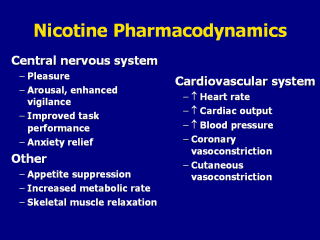| front |1 |2 |3 |4 |5 |6 |7 |8 |9 |10 |11 |12 |13 |14 |15 |16 |17 |18 |19 |20 |21 |22 |23 |24 |25 |26 |27 |28 |29 |30 |31 |32 |33 |34 |35 |36 |37 |38 |review |
 |
Pharmacodynamic effects of nicotine on
the central nervous system (Benowitz, 1992): -Pleasure: Tobacco users commonly report they find tobacco use pleasurable. -Arousal, enhanced vigilance: Tobacco use may help with thinking, concentration, and mood elevation. -Improved task performance: Nicotine has been shown to increase vigilance and performance for some types of tasks (e.g., repetitive/monotonous tasks). -Relief of anxiety: Many tobacco users report reduced anger, tension, and stress after administration. It is not known whether the improvements in mood or task performance are due to relief of nicotine withdrawal symptoms or a direct effect of nicotine on the brain. Pharmacodynamic effects of nicotine on the cardiovascular system: Nicotine’s effects on the cardiovascular system include increased heart rate, cardiac output, and blood pressure as well as cutaneous and coronary vasoconstriction (Benowitz, 1992). After a cigarette is smoked, the smoker’s blood pressure rises by 5–10 mmHg for 15–30 minutes, and the heart rate increases an average of 10–20 beats/min for up to 60 minutes (Benowitz et al., 1988). Studies suggest there is a flat dose-response to the cardiovascular effects of nicotine. This so-called ceiling effect might be due to a rapid but partial development of tolerance to the cardiovascular effects of nicotine (Benowitz, 1997). Other pharmacodynamic effects of nicotine: Nicotine is an effective appetite suppressant and causes modest acute increases in the metabolic rate (Benowitz, 1992). Most people who quit using tobacco will gain weight, although the average person will gain less than 10 pounds (Fiore et al., 2000). Weight gain after tobacco cessation is a major concern for many patients, especially females. Nicotine also causes relaxation of some skeletal muscle (Benowitz, 1992). Benowitz NL. (1992). Cigarette smoking and nicotine addiction. Med Clin N Am 76:415–437. Benowitz NL. (1997). The role of nicotine in smoking-related cardiovascular disease. Prev Med 26:412–417. Benowitz NL, Porchet H, Sheiner L, Jacob P III. (1988). Nicotine absorption and cardiovascular effects with smokeless tobacco use: Comparison with cigarettes and nicotine gum. Clin Pharmacol Ther 44:23–28. Fiore MC, Bailey WC, Cohen SJ, et al. (2000). Treating Tobacco Use and Dependence. Clinical Practice Guideline. Rockville, MD: U.S. Department of Health and Human Services, Public Health Service. Slide is used with permission, Rx for Change: Clinician-Assisted Tobacco Cessation. Copyright © 1999-2007 The Regents of the University of California, University of Southern California, and Western University of Health Sciences. All rights reserved. |